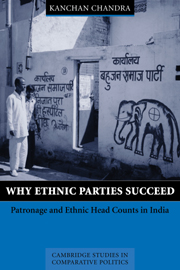Book contents
- Frontmatter
- Dedication
- Contents
- List of Maps, Figures, and Tables
- List of Abbreviations
- A Note on Terminology
- Acknowledgments
- 1 Introduction
- Part I Theory
- 2 Limited Information and Ethnic Categorization
- 3 Patronage-Democracy, Limited Information, and Ethnic Favourit
- 4 Counting Heads: Why Ethnic Parties Succeed in Patronage-Democracies
- 5 Why Parties Have Different Ethnic Head Counts: Party Organization and Elite Incorporation
- Part II Data
- Appendix A Elite Interviews
- Appendix B Ethnographies of Election Campaigns
- Appendix C Content Analysis
- Appendix D Description of Survey Data
- Appendix E Description of the Ecological Inference (EI) Method
- Appendix F Method Used to Estimate Ethnic Voting Patterns
- Bibliography
- Index
- Miscellaneous Endmatter
5 - Why Parties Have Different Ethnic Head Counts: Party Organization and Elite Incorporation
from Part I - Theory
Published online by Cambridge University Press: 19 October 2017
- Frontmatter
- Dedication
- Contents
- List of Maps, Figures, and Tables
- List of Abbreviations
- A Note on Terminology
- Acknowledgments
- 1 Introduction
- Part I Theory
- 2 Limited Information and Ethnic Categorization
- 3 Patronage-Democracy, Limited Information, and Ethnic Favourit
- 4 Counting Heads: Why Ethnic Parties Succeed in Patronage-Democracies
- 5 Why Parties Have Different Ethnic Head Counts: Party Organization and Elite Incorporation
- Part II Data
- Appendix A Elite Interviews
- Appendix B Ethnographies of Election Campaigns
- Appendix C Content Analysis
- Appendix D Description of Survey Data
- Appendix E Description of the Ecological Inference (EI) Method
- Appendix F Method Used to Estimate Ethnic Voting Patterns
- Bibliography
- Index
- Miscellaneous Endmatter
Summary
What determines the initial differences in relative opportunities that a political party in a patronage-democracy offers to elites from different ethnic groups? And, regardless of these initial differences, once it is clear that success depends upon acquiring the correct head count, why might unsuccessful parties fail to adjust their ethnic profiles over repeated elections?
These questions raise a broader theoretical question: Under what conditions are political parties in multiethnic democracies able to incorporate new elites, and under what conditions are they likely to fail? General theories of party politics in multiethnic societies propose a sociological answer to the problem of elite incorporation, according to which success or failure in elite incorporation is determined by the pattern of conflict or harmony between ethnic categories in society. Where ethnic categories are in conflict in society, according to these theories, elites belonging to these categories will not be able to coexist in the same political party. Consequently, multiethnic parties are described as “inherently unstable.” Conversely, ethnic parties, which bring together elites from a single ethnic category, or from socially harmonious ethnic categories, are posited to enjoy a more stable existence.
This chapter proposes a model of elite incorporation that explains the successful incorporation of elites by any political party – whether multiethnic, nonethnic, or ethnic – as a consequence of the internal organizational structure of the party. The model builds upon Myron Weiner's study of the incorporation of new elites in the Congress party in India. According to the model, parties with competitive rules for intraparty advancement, other things being equal, are able to continually incorporate new elites while keeping old ones acquiescent. Such parties are stable parties, better able to retain the allegiance of elites during “lean” periods when they are out of government. Parties with centralized rules of intraparty advancement, other things being equal, are “closed” to the entry of new elites. Such parties are unstable, deeply vulnerable to defections by old elites when they are out of power. The internal organizational structure, I propose, is more influential than the degree of conflict between ethnic groups in society. Where a competitive structure exists, it promotes coexistence even between elites from warring groups in the same party. Where a centralized organizational structure exists, however, we are likely to see splits and defections even within a party dominated by elites from the same ethnic category.
- Type
- Chapter
- Information
- Why Ethnic Parties SucceedPatronage and Ethnic Head Counts in India, pp. 99 - 112Publisher: Cambridge University PressPrint publication year: 2004



